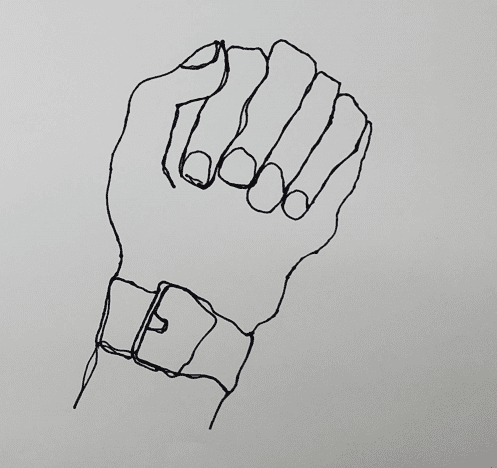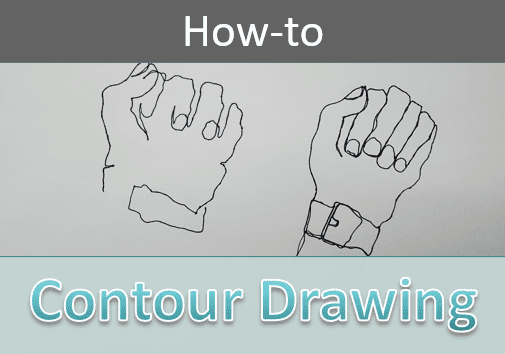Contour Drawing for Beginners
Additionally, contour drawing can be used as a warm-up exercise or as a way to quickly capture the essence of a subject in a loose and expressive manner. Overall, contour drawing is an essential technique for artists of all levels, helping them develop their drawing abilities and artistic vision.
What is Contour Drawing?
Contour drawing is a fundamental drawing technique where an artist creates a line drawing that outlines the edges and contours of a subject. In contour drawing, the artist focuses on the outline or silhouette of the subject, carefully observing its shape, proportions, and details. The emphasis is on capturing the essential features of the subject’s form with a continuous or broken line.
Unlike other drawing methods that may involve shading, rendering, or adding intricate details, contour drawing typically simplifies the subject into its basic shapes and outlines. This technique encourages artists to closely observe the contours and edges of the subject, training their eyes and hands to work together to accurately represent its form.
Contour drawing can be done using various drawing tools, such as pencils, pens, charcoal, or markers, on different surfaces like paper or canvas. It is often used as a foundational exercise in art education to develop skills in observation, hand-eye coordination, and line control.
Benefits of Contour Drawing
- Development of observational skills
- Enhanced hand-eye coordination
- Improved understanding of form, shape, and proportion
- Encouragement of mindfulness and focus
Types of Contour Drawings
Blind Contour
A blind contour drawing is a continuous line drawing done without looking at the paper at all. When doing this type of drawing you focus solely on the subject you are drawing. This trains you to focus your attention on the details of what you’re drawing.
When doing a blind contour drawing you move your hand to follow the contour of the subject as your eyes travel around the subject matter. The result is usually a stylized, and mostly abstract representation of the subject. This is a great exercise for creating a deeper connection with what you’re drawing.
Blind contour drawings help develop an awareness of shapes, lines, and proportions, with an emphasis on line and form.

While blind contour drawing may initially produce drawings that appear awkward or distorted, it is important for artists to embrace imperfections and view them as part of the learning process. Over time, continued practice can lead to greater confidence and proficiency in this unique drawing technique.
Continuous Line Contour
A continuous line drawing is a technique where an artist creates a drawing using a single, unbroken line. In this method, the artist starts drawing from one point and continues without lifting the drawing tool (such as a pen or pencil) from the paper until the drawing is complete. Unlike blind contour drawing, the artist may look at both the subject and the paper while executing a continuous line contour drawing.
The goal of continuous line contour drawing is to capture the essence of the subject’s form with minimal interruption to the line. The aim is to convey the overall shape, contours, and details of the subject in a fluid manner.
By maintaining a continuous line throughout the drawing process, artists can create a sense of unity and movement within their compositions.
Continuous line contour drawing encourages artists to focus on the relationship between different elements of the subject, as well as the flow and rhythm of the lines. It requires careful observation and coordination to navigate the contours and proportions of the subject while keeping the line unbroken.
This drawing technique is valued for its ability to produce expressive and dynamic drawings, as well as its capacity to train artists in hand-eye coordination and spatial awareness. Continuous line contour drawing can be applied to various subjects, including still life, portraits, landscapes, and figure drawing, and it can be executed using different drawing tools and media.
While continuous line contour drawing may present challenges, such as maintaining control over the line and adapting to the subject’s complexities, it offers artists a rewarding opportunity to explore line quality, composition, and personal expression. With practice and experimentation, artists can develop their skills and create captivating drawings using this engaging technique.
Cross-Contour
Cross contour drawing is a technique used to depict the three-dimensional form of a subject by drawing lines that follow its surface contours. Unlike contour drawing, which typically outlines the edges of a form, cross contour drawing involves drawing lines that travel across the form, intersecting and wrapping around its curves, ridges, and valleys.
The purpose of cross contour drawing is to create a sense of volume, depth, and structure within a two-dimensional drawing. By drawing lines that traverse the surface of the subject, artists can convey the form’s three-dimensional qualities, such as its shape, mass, and texture. These lines serve as visual indicators of the subject’s underlying structure, revealing its contours and internal structure.
This drawing technique is commonly used in figure drawing, still life, and observational drawing, as well as in the study of anatomy and form. It helps artists develop their understanding of spatial relationships, light and shadow, and surface textures, enabling them to create more dynamic and lifelike representations of their subjects.
Cross contour drawing is a valuable technique for artists seeking to enhance their ability to depict form and volume convincingly in their drawings, adding depth and realism to their artwork.
Modified Contour
In modified contour drawing, the artist may glance at the paper occasionally while drawing but still focuses primarily on the subject. This approach allows for a bit more control over the drawing process while still emphasizing the importance of observing and capturing the subject’s contours accurately.

The process is basically the same as with blind contour drawings, but you look at your paper occasionally. However, your focus should still be on the subject matter and not your paper.
Common Mistakes and How to Avoid Them
- Lack of Observation – the main purpose of contour drawing is to train the eye to closely observe all of the subject’s contours and details. A common mistake is to not observe these details closely enough. This results in important details being missing from the drawing. To avoid this mistake, force yourself to pay attention to all of the details of the subject and free your mind of the worries about the results.
- Breaking the Line – a common mistake is to break the continuous line by lifting your drawing tool from the paper. This creates the fluidity of the drawing. Keeping your drawing tool on the paper, without lifting it, requires a bit of practice and focus at first since this isn’t how we would normally create a drawing.
- Perfectionism – It’s common for artists to strive for perfection in their drawings, but obsessing over achieving perfect lines or proportions can hinder the spontaneity and expressiveness of contour drawing. Embracing imperfections and allowing for spontaneity can lead to more dynamic and engaging drawings. Have fun with the process of creating contour drawings and allow yourself the freedom to make mistakes.
By being mindful of these common mistakes, artists can develop their contour drawing skills more effectively and produce more compelling and accurate drawings. Regular practice, coupled with patience and a willingness to learn from mistakes, is key to mastering this fundamental drawing technique.
Conclusion
There are a lot of exercises and techniques you can use to develop your art and drawing skills. And contour drawings are just one of many. Try doing a series of different types of drawings. You could try portraits, figure drawing, hands, random objects, or anything you could possibly think of drawing.
By doing several drawings you’ll develop your skills beyond the beginner level. Give it a try and see how you do.
More Art Tutorials
- Continuous Line Self Portraits
- How to Use Line in Art
- The 7 Elements of Art and How to Use them
- Easy Flower Doodles
- How to Warm Up for Art


